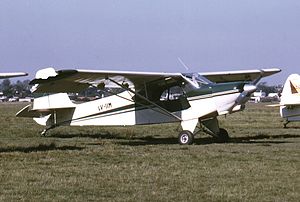- DINFIA IA 46
-
IA 46 Ranquel/Super Ranquel and IA 51 Tehuelche I.A. 46 Super Ranquel at Buenos Aires - San Justo airfield in April 1975. Role Utility and agricultural aircraft Manufacturer DINFIA First flight 23 December 1957[1] Introduction 1958 Status examples still in service Primary user aero clubs Number built >220 The DINFIA IA 46 Ranquel, IA 46 Super Ranquel, and IA 51 Tehuelche were Argentine utility aircraft developed in the late 1950s.
Contents
Development and construction
The intention was to create a light aircraft suitable for aeroclub and agricultural use, and resulting design was a conventional high-wing strut-braced monoplane with fixed tailwheel undercarriage. The aircraft were named for the Ranquel and Tehuelche peoples, different groups indigenous to Patagonia.
The state-owned Dinfia organisation commenced production of the Ranquel at Cordoba in 1958. Construction was of a fabric-covered tubular structure, although the Tehuelche featured metal-covered wings. Accommodation was provided for a single pilot with a bench seat for two people to the rear. In all, some 220 aircraft were built, some of which served as glider tugs for the Fuerza Aerea Argentina.
Operational history
Examples of the IA.46 have served aero clubs from 1958 to date, with several remaining in operation in the late 2000s.
Variants
- IA 46 Ranquel
- Initial production version with Lycoming O-320-A2B engine
-
- IA 46 Super Ranquel
- Version of IA 46 with Lycoming O-360-A1A engine
- IA 51 Tehuelche
- Version with metal-covered wings, larger flaps, and chemical capacity increased to 500 L (130 US gal)
Specifications (IA 46 Ranquel)
Data from Jane's All The World's Aircraft 1965–66[1]
General characteristics
- Crew: One pilot
- Capacity: 2 passengers or 400 L (100 US Gal) of agricultural chemicals
- Length: 7.45 m (24 ft 5 in)
- Wingspan: 11.60 m (38 ft 0 in)
- Height: 2.15 m (7 ft 0 in)
- Wing area: 18.0 m2 (194 ft2)
- Empty weight: 690 kg (1,520 lb)
- Gross weight: 1,160 kg (2,550 lb)
- Powerplant: 1 × Lycoming O-320-A2B engine, 112 kW (150 hp) each
Performance
- Maximum speed: 180 km/h (112 mph)
- Cruising speed: 162 km/h (101 mph)
- Range: 650 km (405 miles)
- Endurance: 4 hours
- Service ceiling: 4,000 m (13,100 ft)
- Rate of climb: 2.4 m/s (472 ft/min)
References
- Taylor, John W. R. (1965). Jane's All The World's Aircraft 1965–66. London: Sampson Low, Marston & Company.
- Taylor, Michael J. H. (1989). Jane's Encyclopedia of Aviation. London: Studio Editions. pp. 326.
- Simpson, R. W. (1995). Airlife's General Aviation. Shrewsbury: Airlife Publishing. pp. 413.
Aircraft produced by FMA/LMAASA/FAdeA MB.1 • MB.2 • ME.1 • MO.1 • MOe.1 • MOe.2 • MS.1 • T.1
FMA 20 • FMA 21 • IAe 22 • IAe 23 • IAe 24 • IAe 25 • IAe 27 • IAe 28 • IAe 30 • IAe 31 • IAe 32 • IAe 33 • IAe 34 • IAe 35 • IAe 36 • IAe 37 • IAe 38 • IA 41 • IA 43 • IA 44 • IA 45 • IA 46 • IA 47 • IAe 48 • IA 49 • IA 50 • IA 51 • IA 52 • IA 53 • IA 54 • IA 55 • IA 56 • IA 58 • IA 59 • IA 60 • IA 62 • IA 63 • IA 66 • IA 67 • IA 68 • IA 70
Lists relating to aviation General Aircraft (manufacturers) · Aircraft engines (manufacturers) · Airlines (defunct) · Airports · Civil authorities · Museums · Registration prefixes · Rotorcraft (manufacturers) · TimelineMilitary Accidents/incidents Records Categories:- Argentine civil utility aircraft 1950–1959
- Argentine agricultural aircraft 1950–1959
- FMA aircraft
Wikimedia Foundation. 2010.

